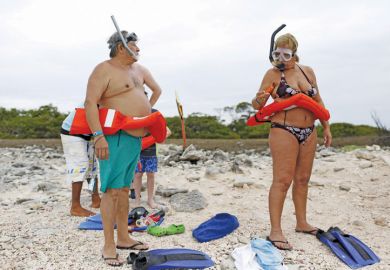George Kennan, diplomatist, analyst, essayist, memoirist, diarist, belletrist and beltelegrammist - there are fragments of all of them in his latest collection - is the putative philosopher-king of the American republic. More convincing than Clark Clifford, more compassionate than Paul Nitze, more contrary than John Kenneth Galbraith, he has outlived and outwritten all the rest. His prodigious meditations on the history of our present discontents fairly throb with the intensity of their author's personal experience, and his own awareness of its fabulous unrepeatability. Kennan's fascination now is his survivor status. He is a survivor of the short 20th century, as he himself remarks, which is to say that the arc of his active life describes the whole history of Soviet-American relations. He is fossil, oracle and almanac rolled into one.
Born in Milwaukee, Wisconsin, in 1904, educated at Princeton, schooled in Berlin as one of the fledgling Russianists of the US Foreign Service, Kennan was posted - or outposted - in the early 1930s to Riga, on the Baltic coast of Latvia, then enjoying a precarious 20-year intermission of independence between the suffocating embrace of Mother Russia and the strangulating grip of Uncle Joe. From this vantage point he was to study the Soviet Union. He could get no nearer because diplomatic relations between Moscow and Washington had not yet been established. So Kennan became a Sovietologist avant la lettre. Sight unseen - romantically yet remotely, and, it is tempting to think, characteristically - he also fell in love.
He has described the experience with passionate restraint in a finely modulated essay from the New Yorker, "Flashbacks" (1985), one of the jewels of this collection: "The city of Riga is itself a smaller edition of the pre-revolutionary St Petersburg, but without the palaces. The sleigh in which I am sometimes driven to the office in winter - a one-passenger open-air affair, in which the fur-coated passenger sits behind and below the massive figure of the bundled coachman on the box - is right out of Tolstoy. In summer, because we are poor, we live in a little wooden cottage out at the seashore. I commute on the suburban trains. The trains and the passengers, I among them, seem to be right out of Chekhov's stories. And if one goes farther into the countryside, all that one sees - the cobbled roads, the swamps and fields, the birch trees and evergreen forests - is the purest Russia. I drink it all in, love it intensely, and feel myself for a time an inhabitant of that older Russia, which I shall never see again in the flesh."
Soon Kennan saw in close-up. In 1934 he helped to open the first American embassy in the unpromising, other-worldly Moscow that was the seat of Stalin's murderous paranoia. He has been observing and absorbing the behaviour and temperament of his inamorata ever since, as a professional diplomat in the later 1930s, in 1944-46 and 1952, and on subsequent occasions as a distinguished academician. Over the same period, in consequence of this quasi-anthropological fascination, he has been documenting his responses to what he found. He is not merely a reflective but even a reflexive participant-observer, sensitive, self-conscious, and sentimental.
For all its sweep and symmetry, his career remains extremely difficult to interpret, as is evident from the contradictory readings embedded in America and the World, a representative and rather incestuous sample of the best survey articles of recent years from the journal Diplomatic History - the history of Americans, by Americans (mostly John and Bruce and Mel and Mike, who have catty things to say about each other and profess themselves the better for it), for Americans.
Kennan by contrast is curiously displaced, "an expatriate in time", as he says of himself. His combination of expertise and experience is unmatched. His sense of public duty is developed to the highest degree. His greatest wish is that we were all sentient international citizens. Contrary to popular belief he is as much moralist as realist. His watchword, in art and life, is seriousness. He is widely seen as almost incorrigibly prophetic, or at the very least premonitory. (And there are intimations here that this is how he sees himself.) Yet his service to his country has been disappointingly - one might say brutally - curtailed. The high salience of his ideas in Washington was confined to a brief, pivotal, accidental, astonishingly fertile period in 1946-47 - a period much shorter than is commonly supposed - under the patronage of James Forrestal as secretary of the navy (and later defence) and George Marshall as secretary of state, an unlikely combination. These two men harnessed Kennan's uncontainable urge to write.
In his mid-thirties he began a substantial work of autobiography, Fair Day, Adieu! (the title itself quintessential Kennan), later abandoned but utilised in two volumes of scrupulously composed Memoirs (1967 and 1972).
Briefly interned by the Nazis in 1942, he began a novel about life in the Foreign Service. There is some suggestion of an unpublished biography of his great exemplar Chekhov. There is a small mountain of scholarly books and a high alp of private papers, including speeches not delivered and letters not sent - truly a throwback to the 18th century - at least one of them (to Walter Lippmann) of considerable historical interest.
In keeping with this avocation, Kennan's influence rests on three official or semi-official papers of exceptional range, density, erudition and, it must be said, length. Two of them are well-known, the other less so: the clarion-call "Long Telegram" of February 22 1946 from Moscow; the programmatic "Mr X" article on "The sources of Soviet conduct" published in the house journal of the American political establishment, Foreign Affairs, in July 1947; and the magisterial report of May 23 1947 on "Certain aspects of the European recovery problem from the United States' standpoint", which consolidated State Department thinking on what was about to become the Marshall Plan.
The "X" article in particular lingers in the collective memory, with its potent mixture of moral exhortation to the United States to "measure up to its own best traditions and prove itself worthy of preservation as a great nation" (a theme he is pursuing still), its alluring prevision, 40 years postponed, of "either the break-up or the gradual mellowing of Soviet power", and its famous, ambiguous, policy prescription: "long-term, patient, but firm and vigilant application of counterforce at a series of constantly shifting geographical and political points, corresponding to the shifts and manoeuvres of Soviet policy".
A new doctrine for US foreign policy had been adumbrated. Just as Winston Churchill appropriated the image of an "Iron Curtain", so George Kennan became identified with the concept of "containment". Mr X was unmasked within weeks. Recognition came with a vengeance. Kennan, it seemed, had codified the Cold War. Like many other celebrities, he soon felt trapped by the source of his fame. He saw his meaning distorted and his message misread. Containment in practice was excoriated by Lippmann, among others, as a strategic monstrosity, reactive, indiscriminate, militarised, above all flagrantly and dangerously nuclear-dependent - charges with which the author of the doctrine came to sympathise, as he reiterates again and again, a shade forlornly perhaps, in these pages.
At the close of the 40-year melee, Kennan's case is replete with irony. Throughout his career the consummate stylist has been misunderstood, the prophetic analyst simply ignored. Before 1946 all was ennui and threatened resignation. After 1948, a creeping marginalisation set in. Kennan increasingly found himself out of temper with the times, the self-styled "court jester" of the State Department. In 1952, as ambassador to the Soviet Union, the American who above all others could lay claim to a sympathetic understanding of that country and its people was declared persona non grata after publicly comparing the conditions in Moscow with those of his internment ten years earlier.
In 1953, his services no longer required by John Foster Dulles and the incoming Eisenhower administration, Kennan retreated to his true spiritual home - there is a strong spiritual undertow to this collection - the Institute for Advanced Study at Princeton, at the invitation of the man who was in many ways his counterpart casualty, Robert Oppenheimer. In the outside world Kennan always seemed to have some explaining to do. At Princeton he could walk by himself.
The tragedy of American diplomacy - "our attention has been concentrated, too closely and for too long, on the sterile and hopeless mathematics of military rivalry that was in part the product of own feverish imagination and of our own inspiration", he told the Council on Foreign Relations in December 1989 - was in every sense a personal tragedy for George Kennan. The Cold War made him and the Cold War unmade him. These memorable Reflections, instinct with mortality, laced with melancholy, appear to constitute his valedictory dispatch. It is hard to imagine their dislocated author at ease in the 21st century.
Taken together, they present themselves as an extended homily on the necessities and possibilities of international civility - a priceless commodity, all but irrecoverable. "At the end of this sad century, still partially crippled, genetically and morally, by the injuries we brought to ourselves in the two internecine wars of the earlier decades", this tortuously admirable expatriate contrives to show us how we might recover it.
Alex Danchev is professor of international relations, Keele University.
America in the World: The Historiography of American Foreign Relations
Editor - Michael J. Hogan
ISBN - 0 521 49680 2 and 49807 4
Publisher - Cambridge University Press
Price - £40.00 and £14.95
Pages - 619
Register to continue
Why register?
- Registration is free and only takes a moment
- Once registered, you can read 3 articles a month
- Sign up for our newsletter
Subscribe
Or subscribe for unlimited access to:
- Unlimited access to news, views, insights & reviews
- Digital editions
- Digital access to THE’s university and college rankings analysis
Already registered or a current subscriber?



